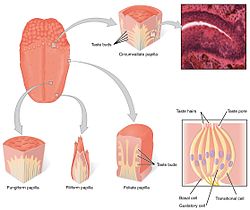This article needs additional citations for verification. (December 2020) |
| Taste buds | |
|---|---|
 Taste buds are small structures present within the papillae of the tongue | |
| Details | |
| System | Taste |
| Identifiers | |
| Latin | caliculus gustatererius |
| MeSH | D013650 |
| NeuroLex ID | birnlex_4101 |
| TA98 | A15.4.00.002 |
| TA2 | 7037 |
| TH | H3.04.01.0.02116, H3.04.01.0.03013 |
| FMA | 54825 |
| Anatomical terms of microanatomy | |
Taste buds are clusters of taste receptor cells, which are also known as gustatory cells.[1] The taste receptors are located around the small structures known as papillae found on the upper surface of the tongue, soft palate, upper esophagus, the cheek, and epiglottis. These structures are involved in detecting the five elements of taste perception: saltiness, sourness, bitterness, sweetness and savoriness (umami). A popular assumption assigns these different tastes to different regions of the tongue; in actuality, these tastes can be detected by any area of the tongue. Via small openings in the tongue epithelium, called taste pores, parts of the food dissolved in saliva come into contact with the taste receptors.[1] These are located on top of the taste receptor cells that constitute the taste buds. The taste receptor cells send information detected by clusters of various receptors and ion channels to the gustatory areas of the brain via the seventh, ninth and tenth cranial nerves.
On average, the human tongue has 2,000–8,000 taste buds.[2] The average lifespan of these is estimated to be 10 days.[3]
- ^ a b Shier, David (2016). Hole's Human Anatomy and Physiology. New York: McGraw-Hill Education. pp. 454–455. ISBN 978-0-07-802429-0.
- ^ Encyclopædia Britannica. 2009. Encyclopædia Britannica Online.
- ^ Hamamichi, R.; Asano-Miyoshi, M.; Emori, Y. (15 September 2006). "Taste bud contains both short-lived and long-lived cell populations". Neuroscience. 141 (4): 2129–2138. doi:10.1016/j.neuroscience.2006.05.061. PMID 16843606. S2CID 24014479.